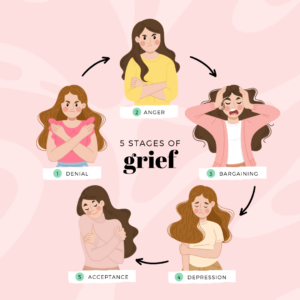Navigating the Depths of Grief: Understanding the Stages, Levels, and Types.

I. The Five Stages of Grief:
Elisabeth Kübler-Ross, a renowned psychiatrist, introduced the five stages of grief in her groundbreaking book “On Death and Dying.” These stages provide a framework to comprehend the emotional process individuals undergo when faced with loss:
- **Denial:**
– Initial shock and disbelief.
– A sense of unreality and an attempt to block out the pain.
- **Anger:**
– Feelings of frustration and resentment.
– Anger directed towards oneself, others, or even the situation.
- **Bargaining:**
– Attempts to negotiate or make deals to reverse or alleviate the loss.
– Searching for meaning and ways to regain control.
- **Depression:**
– Overwhelming sadness and a deep sense of hopelessness.
– Withdrawal from daily activities and a struggle to find joy.
- **Acceptance:**
– Coming to terms with the reality of the loss.
– Finding a way to move forward while honouring the memories.
It is important to note that these stages are not linear, and individuals may move back and forth between them in a non-linear fashion.
II. Levels of Grief:
Grief is a multi-dimensional experience that manifests at various levels, affecting individuals on emotional, physical, cognitive, behavioural, and spiritual planes:
- **Emotional Level:**
– Intense feelings of sadness, guilt, anger, or anxiety.
– Waves of grief that may be triggered by memories or reminders.
- **Physical Level:**
– Physical symptoms such as fatigue, headaches, changes in appetite, or sleep disturbances.
– The mind-body connection in grief is profound and can impact overall well-being.
- **Cognitive Level:**
– Difficulty concentrating and making decisions.
– Persistent thoughts about the loss and a re-evaluation of life’s meaning.
- **Behavioural Level:**
– Changes in social interactions, withdrawal from others, or seeking support.
– Coping mechanisms, both healthy and unhealthy, to deal with the pain.
- **Spiritual Level:**
– A quest for meaning and a reassessment of personal beliefs.
– The search for a sense of connection and purpose in the face of loss.
III. Types of Grief:
Beyond the general stages and levels, grief can take on different forms based on the nature of the loss:
- **Anticipatory Grief:**
– Grieving in advance when facing a foreseeable loss, such as a terminal illness diagnosis.
– Allows individuals to begin the emotional preparation for an impending loss.
- **Complicated Grief:**
– Prolonged and intense grief that hinders daily functioning.
– Difficulty accepting the reality of the loss, leading to persistent distress.
- **Disenfranchised Grief:**
– Grieving a loss that is not openly acknowledged or socially supported.
– Examples include the loss of a pet or the end of a non-traditional relationship.
- **Collective Grief:**
– Shared grief experienced by communities or societies in response to collective traumas or events.
– Examples include natural disasters, pandemics, or acts of terrorism.
Grief is a universal experience, yet its expression is profoundly individual. Understanding the stages, levels, and types of grief can provide a roadmap for those navigating the difficult journey of loss. It is crucial to recognize the uniqueness of each person’s grief and to offer support, empathy, and resources to help them heal in their own time and way. As we explore the intricate tapestry of grief, we can learn to approach the subject with compassion and a deeper understanding of the human experience.
ABOUT THE CONTRIBUTOR

If you would like to connect with Psychic Bella please Click Here to find out more about Psychic Bella or call using Phone Code 1441.











